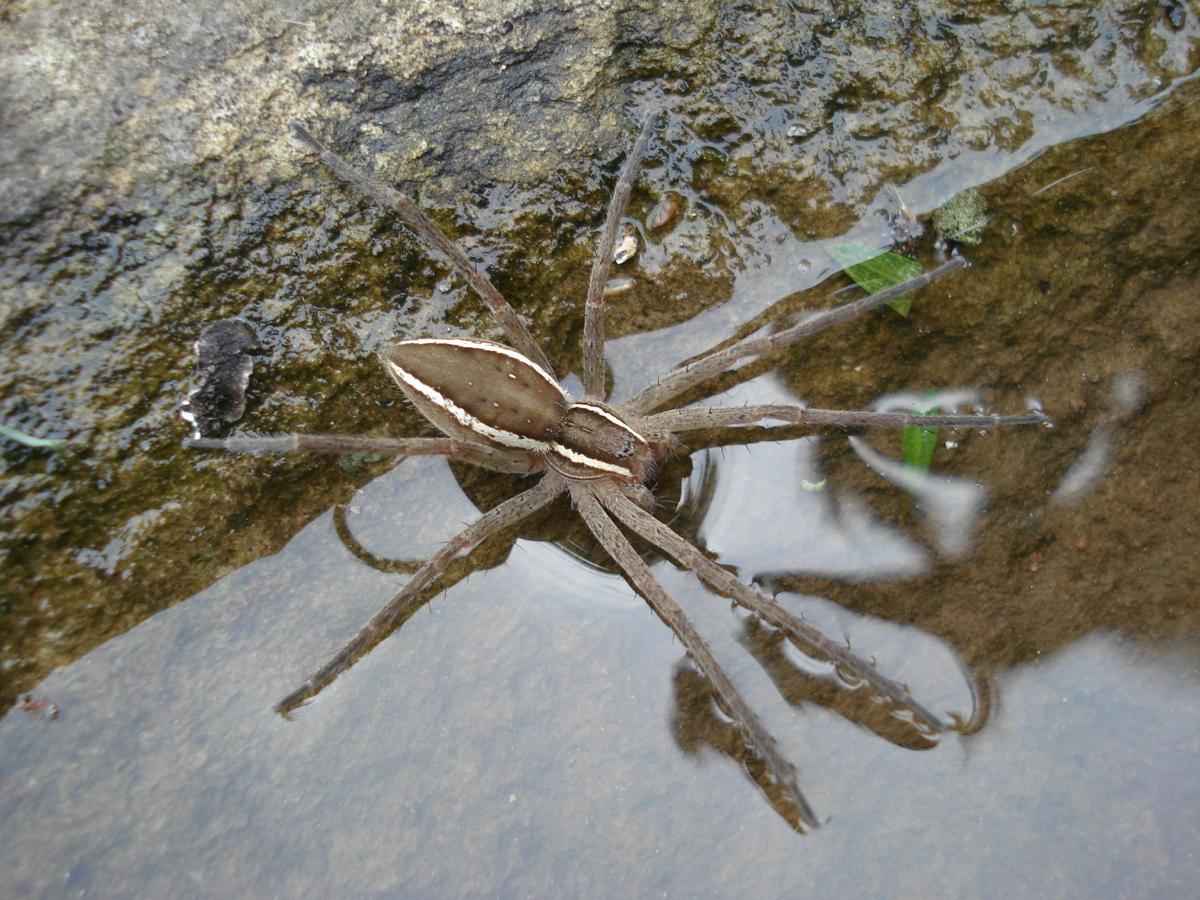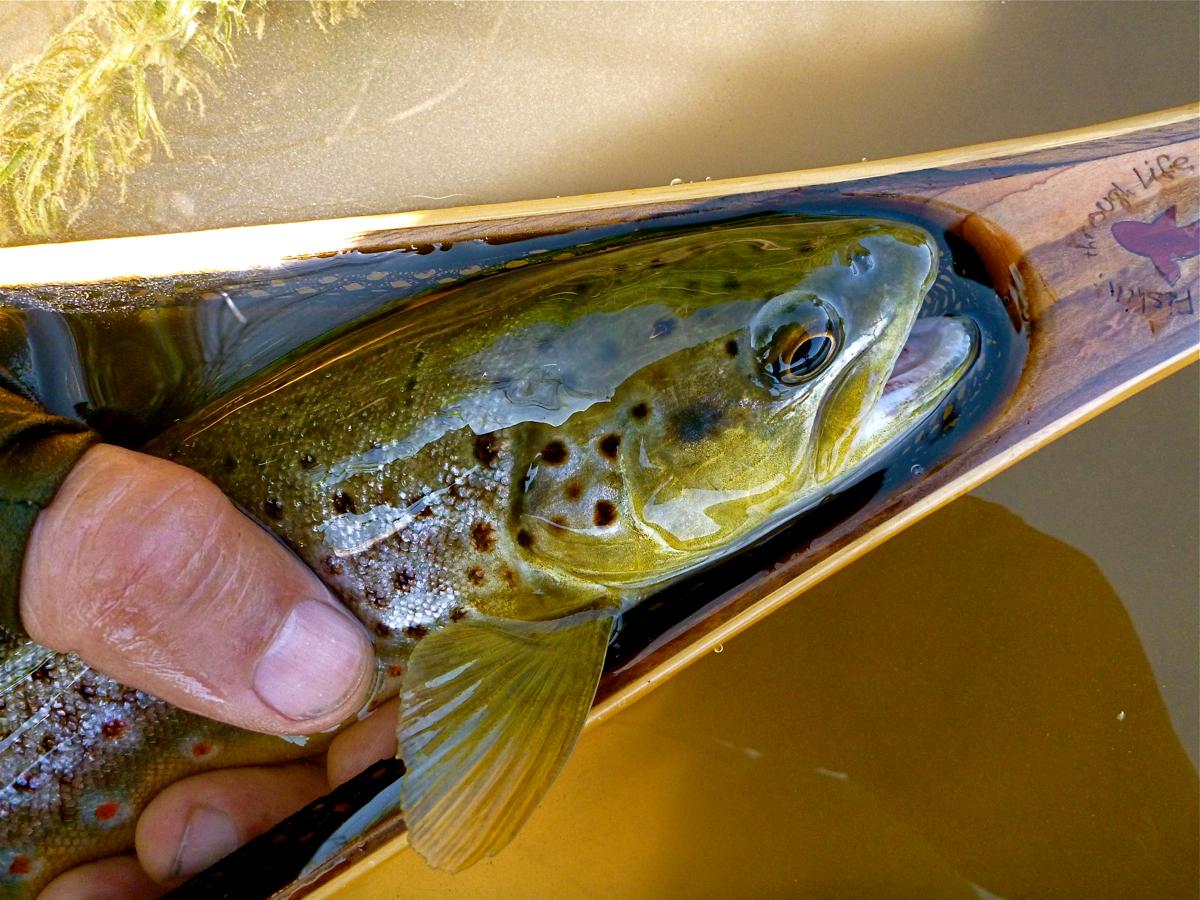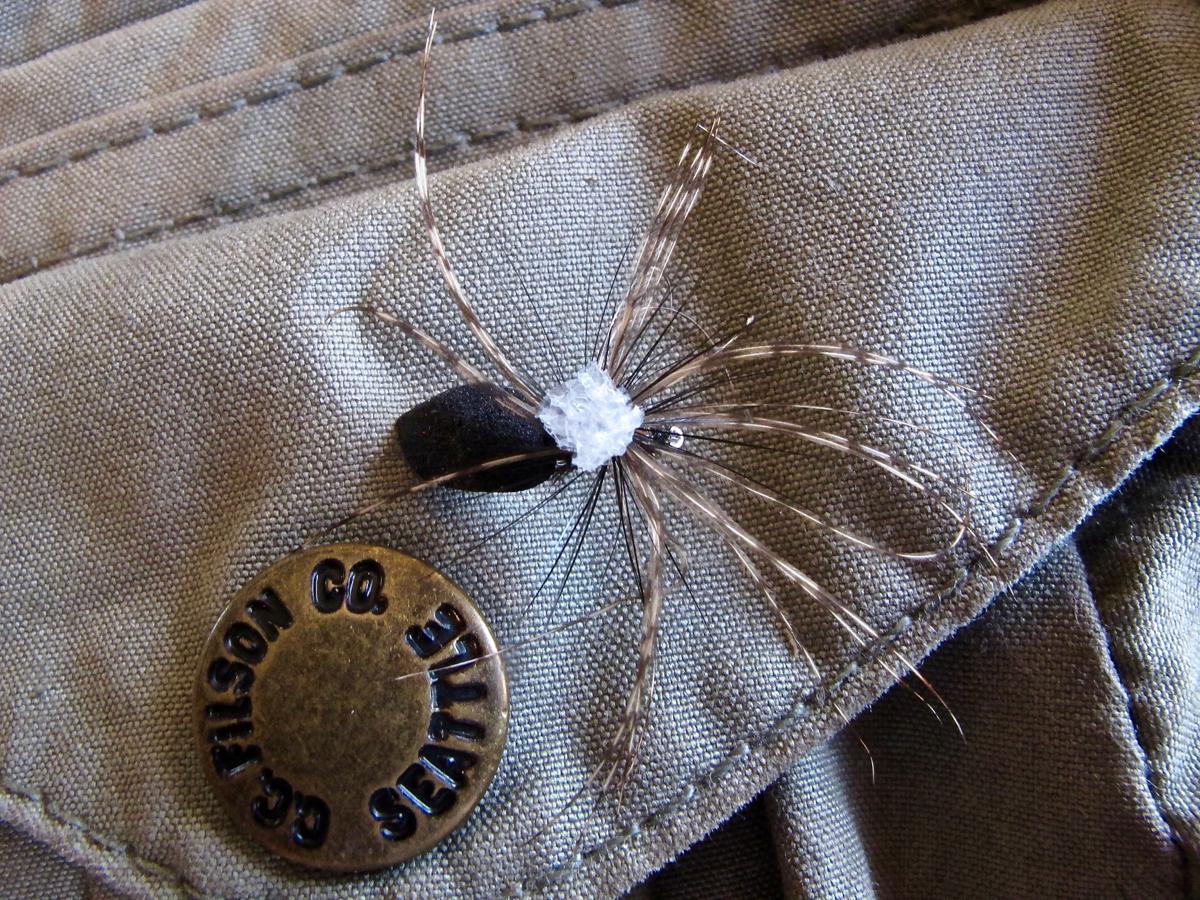
14 minute read
The Wolf Spider and its origins Heritage Flies - Part 6
Imitations of particular spider species are relatively unique to South Africa for the techniques and materials used by a number of local fly tyers. Perhaps there is no better example than that of the local Lycosid Wolf Spider that is found throughout the country and fairly often spotted in and around structure close to the streams as it searches for prey close to the waters edge - the result is that some, not by choice, end up in the stream struggling to make it back to the safety of terra firma.
In his milestone book, The Dry Fly – New Angles (Globe Pequot Press, 2001), Gary LaFontaine wrote that a trout holding in deep water and strong currents would be most tempted to rise to a ‘wide’ fly. To justify the expenditure of energy it also required a ‘big chunk’ i.e. a food item that would provide a lot of calories and a ‘sitting duck’ i.e. a food item that looked vulnerable and was not likely to escape. The original Mackereth Wolf Spider and subsequent three imitations possess these triggers.
Advertisement
The earliest documented imitation was in the 1960s. A fly which symbolised a radical change in fly fishing technique as it was then practised in South Africa. The Caribou Spider was tied by a British expat, Mark Mackereth. It was probably the first local fly made of spun and clipped deer hair and the first tied specifically to imitate the Wolf Spider. In the light of the significance of this first Wolf Spider pattern and Mark Mackereth’s contribution
Prior to Mark’s arrival in South Africa it was customary to concentrate on the deep pools and to fish big wet flies like the Mrs Simpson downstream, often on a sinking line. Mark fished the dry fly upstream on a floating line, concentrating rather on the runs, riffles and pocket water.
The Caribou Spider had no tail and the parachute was constructed by tying the stripped quill into a loop which was held upright by a gallows tool. The hackle was wound laterally around this quill loop, the feather tip was then threaded through the loop and the quill was pulled to tighten the loop around the feather, leaving the tip of the feather pointing forward. Later commercial versions saw the hackle feather wound around a post of red chenille which made it easier to follow on the water and a hackle fibre tail was added. It floats like a cork, is easy to follow in the most boisterous of currents and has proved successful for half a century.
Mark was born on Christmas day 1907 in Stillington, Yorkshire but grew up on a farm in the nearby town of Pickering where he fished for trout and salmon. His parents reluctantly conceded to his decision to choose music rather than farming as a career. The outbreak of WWII interrupted his musical studies and he saw action at Dunkirk and in the subsequent Normandy campaign. After the war, while doing guard duty at the Tower of London, he met a South African woman, Eileen Watkins, who was a friend of the family of the Officer Commanding the Tower and who introduced them.

For South African fly fishers it was a fortuitous romance. The couple left for South Africa in 1951 after Mark had been offered a position as a double bass player with the Johannesburg Symphony Orchestra. Ten years later he took a transfer to the Cape Town Symphony Orchestra. Mark joined the Cape Piscatorial Society, and discovered the Smalblaar which, in issue number 53 of the CPS magazine, Piscator, he described as a “delightful little river”.
Perhaps his most significant role was as mentor to a new generation of CPS Young Turks who were chafing against a decadesold regimen of tactics prescribed by the luminaries of the day such as Sydney Hey a n d F r e d B o w k e r ( K i n g f i s h e r ) , t h e manipulated wet fly, often based on gaudy salmon patterns and fished under tension across or downstream.

when he was interviewed for the DVD, A South African fly tying journey with Ed Herbst and friends that it was learned how Mark developed the fly to imitate the wolf spider which was common on the banks of the Holsloot and Smalblaar streams near Worcester and that it therefore did not have a tail. On the DVD Tom ties the modern version with a parachute post.
He described how Mackereth’s sister, who lived in Canada and was due to visit Mark and his wife in Cape Town, was asked to bring out any fly tying materials she could find. She brought with her a piece of caribou (reindeer) skin. It spins beautifully and Mark combined a spun and clipped body of caribou with a parachute hackle wound around the feather’s looped quill. Mark apparently said at the time that the inspiration for the fly was American – possibly the original Rat Faced McDougal with grizzly hackle tip wings.
“During his time in Johannesburg he befriended Leo Rosettenstein, then owner of the iconic hunting and fishing shop, Arms and Ammunition located in Bree Street in the city centre. One night after dinner at Leo’s house, Leo mentioned to Mark that he had a small collection of game cocks that he used for hackle. Mark insisted on seeing them there and then. Armed with a torch, Leo showed him a few birds roosting in a peach tree. In a flash Mark grabbed the bestlooking fowl by its feet and marched it inside where he divested it of a heap of its prime neck hackles. This story was related to me by Leo himself.”
“Mark and I frequently fished the Holsloot River and along the road we passed close by a number of farms. We often stopped at Gevonden just before Rawsonville for, as Mark put it, 'a little inspection'. Folk would be going about their business around their cottages, but when Mark stepped out of the car he was instantly recognised as the feather man’. The farm yard would erupt into a cacophony of screeching roosters as men, women and children chased the better birds Mark pointed out, the red, ginger and white game cocks, but only the ones with the longer spurs. He’d take envelopes and a pair of scissors from his shirt pocket and in five minutes he’d snipped off the best of the neck feathers and handed over a rand or two. His parting shot was often, ‘I will be back’. I’d see them in the rear view mirror as we left, staring incredulously at the money they had just earned for a couple of feathers – and no doubt hoping he would be back!”
He was recognised as a consummate e x p e r t s t e e p e d i n t h e t r a d i t i o n o f gentlemanly conduct on the water, coupled

with a deep respect and appreciation of nature and living things. He was only too willing to share his vast, intuitive knowledge and techniques.
It is said that he will be remembered forever for his gentle dexterity and control of his split cane rod, an irresistible presentation of the fly, adjusting his cast for any situation, gently coiling the fly line in the palm of his hand and playing and landing the fish.
An entry in Piscator, journal of the Cape Piscatorial Society dated 29 November 1974 aptly sums up this fly and its creator: “Smalblaar – Boundary to weir pool. Eight rainbows. One of 1lb, two of 12 oz. and five of about 8 oz. on a much used Caribou Spider not changed although bitten by very many undersize fish.”

Fifty years later three fly fishers, Fred Steynberg in Rhodes in the North Eastern Cape, Leonard Flemming in Stellenbosch and Peter Brigg in Durban developed their own patterns after realising that wolf spiders are taken avidly by trout.
But Mark Mackereth was the first. His role in closing a chapter on the past, popularising the upstream dry fly and in inspiring a new generation of fly fishers who were, in their own right, to impact massively on the evolution of South African fly fishing and fly tying, deserves recognition. His ashes were scattered on his beloved Smalblaar stream.
Original RAB tied by Tony Biggs TVN original version As Pieter Cronje fellow member of the Cape Piscatorial Society put it: “Such a mentor comes but once in a lifetime.”
“This imitation of the wolf spider combines the movement and seductive speckling of a parachute partridge hackle, with the gleam of a black or blue dun hackle tied beneath it to strengthen and support it. The idea of a small, stiff rooster hackle behind a bigger one is attributed to Dr William Baigent of Northallerton in England who died in 1935 aged 71. Baigent started using these flies around 1875 on Yorkshire streams and his idea was to create an illusion of movement.
“The term halo hackle was used as far back as in the November 1984 issue of the British magazine, Trout Fisherman. It was in an article by John Ketley called, “Tyings to Test a Saint”. Ketley had modified Baigent’s idea by winding the smaller hackle through the bigger one to reinforce it. “The black Wapsi body – which has a tortoise-shell shape - is tied as an extended body at the bend of size 14 to 16 fine wire sedge hook such as the Tiemco 206 BL, the Grip 14723 BL, the Gamakatsu C13U or the Varivas IWI T-2000 Terrestrial. To make the fly more visible a white or brightly-colored post is tied in slightly behind the hook eye to provide the support for the partridge and dun rooster hackles which will be wound around it, parachute style. This stands out and contrasts nicely with the black foam behind it. I use translucent ethafoam packaging material although, it could substituted for a brighter material. The thorax of the spider is lightly dubbed with black or brown CDC dubbing to add to the buoyancy of the fly. A black or dark dun cock under hackle, is first tied in around the post. This hackle should be sparse – no more than two wraps – and the fibres should be just longer than the gape measurement of the hook.

“The legs of the spider are imitated with a brown Hungarian Partridge hackle tied in by the butt and sparsely wrapped with a single turn around the base of the post and it is necessary to tie it in with the shiny side of the feather facing upwards so that the hackle tips droop enticingly into the water. The legs should be about 15 to 20mm long.
“The most salient feature of this pattern is a parachute halo hackle which combines a small rooster hackle beneath and supporting a partridge hackle, a development which I attribute to Tom Sutcliffe.”

www.saflyfishingmag.co.za 56 Return to contents Original RAB tied by Tony Biggs TVN original version Leonard’s Wolf Spider Leonard says - "I recall an incident while fishing a small Cape stream during the late season. Settled next to a decent pool I found myself fumbling in my fly box after a 10 inch rainbow had refused my fly. After selecting a fly, I watched the pale figure of the trout glide to and fro in the current while tying the fly to my tippet. A movement to the right of the inlet caught my eye and almost instantly the trout leapt clear of the water and grabbed in midair a long-jawed water spider that was dangling by its silken thread from a streamside bush. After first observing a trout take a wolf spider, I came up with an imitation that I found to be exceptional and equally successful on streams throughout the country." ”This Wolf Spider pattern suits my criteria of a good dry fly; it sits low in the water (due to the parachute), yet it drifts well and is sufficiently buoyant to serve as an indicator fly with a nymph suspended beneath it. It is highly visible on the water and imitates the natural well, but also everything in general. While some arachnid imitations utilise rubber legs, I find that pheasant tail is a better choice because they hold their shape and do not clump together."
The abdomen is black foam covered with thin layer of hare’s ear dubbing, with Egyptian goose (or partridge) chest feather fibres folded over the top (tied in first, at the bend of the hook). Eight pheasant tail fibres make up the legs tied behind and in front of the parachute post with two pairs each side f a c i n g b a c k w a r d s a n d f o r w a r d s , respectively. The post is Egyptian goose chest feather fibres or white yarn. The hackle is formed by using a single grizzly hackle feather (wrapped in first), followed by a brown hackle. (Wet the base of the post with varnish before spinning the hackle around the post).

Pete’s Spider
Peter says -
“Anatomically, the wolf spiders, Lycosidae, like most spiders, are fused into two sections, the cephalothorax and abdomen, and joined by a small, cylindrical pedicel. They are air-breathing and unlike other insects they do not have antennae and no muscles in their eight legs which are operated instead by hydraulic pressure; pretty neat, but that is one aspect you won’t need to imitate. Spiders rank seventh in total species diversity among all other groups of organisms and are found worldwide except in Antarctica. They have become established in nearly every ecological niche around the globe with the exception of air and sea.
Original RAB tied by Tony Biggs TVN original version “All of this got me thinking about creating a s p i d e r p a t t e r n o f m y o w n a n d acknowledging the limitations of the dexterity and nimbleness my ten thumbs, simple seemed to be the answer. And, I have found that the fish are not particularly fussy about size, number and length of the appendages. In fact it seems that bigger is better and the longer the legs, the more attractive they are to our piscatorial friends.
“What I wanted was a fly that would be easy to tie, durable, float well and low on the sur face, have a distinctive profile - recognisable through familiarity as something that exists in stream environments, something that has been eaten and enjoyed before. My first attempts were a little messy and quickly lost their shape. Being such an important element of the design, it was back to the drawing board."
“My variation of the Wolf Spider or as Tom Sutcliffe called it, Pete’s Spider, in his wonderful new book, Yet More Sweet Days, is also a good searching pattern even when the fish are being less than cooperative. Importantly though, it has an easily recognisable prey profile and can be effectively fished anywhere on the stream, although experience shows that drifting the fly along the edges of the banks and below over-hanging vegetation where they are most likely to first end up on the water brings the greatest success. It is also worthwhile to twitch the rod tip occasionally and skate the fly over the surface to imitate the behavior of another fairly common aquatic species of spider (Dolomites), the Fishing Spider found in our waters and similar in profile to the Wolf Spider. They feed by sensing vibrations of struggling prey and chasing after it by running across the water."
“I have been through a number of variations and materials based on experience, and without compromising the profile, but to find the best combination to improved durability. The front legs of Pheasant tail or similar feather fibres have always been the weak point usually being damaged after a few strikes or loose their position. I have settled on a pinch of squirrel tail hairs in a fan shape over the hook eye as a good substitute. This variation has proved it’s worth and is far more durable. Experience has shown that this latest variation is no less effective at fooling trout than the original with its feather fibre front legs."
For detailed tying instructions to tying Pete’s S p i d e r , s e e - https:// callofthestream.wordpress.com/2018/01/08/ tying-the-wolf-spider/












